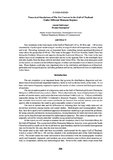Numerical Simulations of the Net Current in the Gulf of Thailand under Different Monsoon Regimes
Share
ບົດຄັດຫຍໍ້
Net circulation in the three layers in the Gulf of Thailand 0-10 m, 10-40 m and >40 m were simulated by a hydrological model using tri-monthly average of observed temperature, salinity, depth and wind. Prevailing monsoon was an important factor controlling current speed and direction of water above the pycnocline (0-40 m). The water in the upper 10 m flew from the South China Sea during the Northeast Monsoon and opposite during the Southwest Monsoon. The water in the near surface layer in all simulations was replenished mainly by the opposite flow in the mid-depth layer and only slightly from the deep, nutrient enriched, water below 40 m. The true circulation gyre could not be seen in our simulations but different degrees of eddies and meanders were evident in almost all runs. These features could play very important roles in the distribution and dispersion of dissolved, particulate and biological species, including pollution and larvae, and deserved more in depth studies in the future.
Suggested Citation
Snidvongs, A., & Sojisuporn, P. (1999). Numerical simulations of the net current in the gulf of Thailand under different monsoon regimes. In Proceedings of the First Technical Seminar on Marine Fishery Resources Survey in the South China Sea, Area I: Gulf of Thailand and Peninsular Malaysia, 24-26 November 1997, Bangkok, Thailand (pp. 54-72). Samutprakan, Thailand: Training Department, Southeast Asian Fisheries Development Center.


